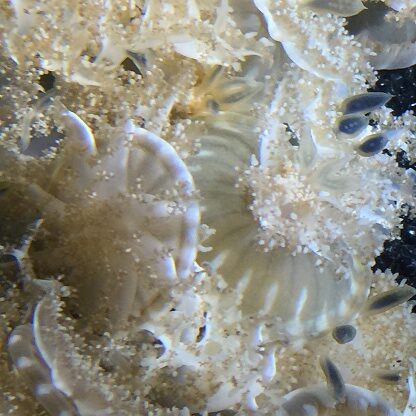ANIMAL: Frilled/Mangrove Upside-Down Jellyfish Cassiopea xamachana Type of Animal: Upside-Down Jellyfish Habitat: Muddy bottoms of inshore bays, muddy seabeds of shallow lagoons, tropical inshore shallow sandy mudflats, muddy substrate in/among mangroves, shallow mangrove areas, shallow benthic areas, shallow tropical reefs, nutrient-rich anchialine ponds, muddy pond bottoms, estuaries, can be found in marine & brackish waters Location(s): W Atlantic, Caribbean, & Gulf of Mexico Appearance: Saucer-shaped bell underneath, 4 pairs of tentacles on upperside, variable in color Food/Diet: Zooplankton, phytoplankton, algae, fish eggs, fish larvae, copepods, planktonic eggs, brine shrimp, detritus Status in Wild: Stable Conservation: Local protections in certain areas. Protection of mangrove habitats. Lifestyle: Swarms/blooms can range from 10 to as many as 5,000 jellyfish Additional Info: Called: Adult: Medusa Young: Planula/Ephyra Group: Swarm/Bloom/Smack Diameter: 11.81 in Gestation: 1 week Life Span: 1-4 years Body Length: 7.99-14.02 in Main predators are sea turtles. Reproduce both sexually & asexually. Start life out as free-swimming larval planulae until settling on substrate. Once planulae settle, they metamorphose into hydroid stage, forming tiny sessile polyps called scyphistomae. This stage reproduces asexually by budding, forming more scyphistomae. During this time, they’ll have acquired zooxanthellae. When they get zooxanthellae & temps exceed 68 F, strobilation/transverse fission occurs in which asexual stage splits, becoming ephyrae (young medusae). Soon after, they reach medusa (adult) stage. Medusae reproduce sexually w/ male medusa releasing sperm into water & female receiving that sperm. Fertilization occurs in female’s body. They have mutualistic relationship w/ zooxanthellae (photosynthetic dinoflagellates). Jellyfish take in nutrients to suit requirements of zooxanthellae & zooxanthellae carry out photosynthesis benefiting jellyfish. These jellyfish are highly sedentary. These jellyfish will pulsate bells & rise in water if disturbed. Bell acts like suction cup to stabilize jellyfish. Fun Fact(s): These animals are 95% water. They lack hearts/brains/blood/gills. Get name due to frilly appearance & looking like they’re upside-down. Also called Mangrove Jellyfish, Cabbage-Head Jellyfish, & Many-Mouthed Jellyfish. These jellyfish can sting without touching due to releasing large mucus layers (cassiosomes), which is full of nematocysts (stinging cells). These cassiophores can survive for up to 10 days independently. Can obtain food from a distance due to cassiophores. They also obtain food using stinging cells in tentacles. They also filter-feed.
